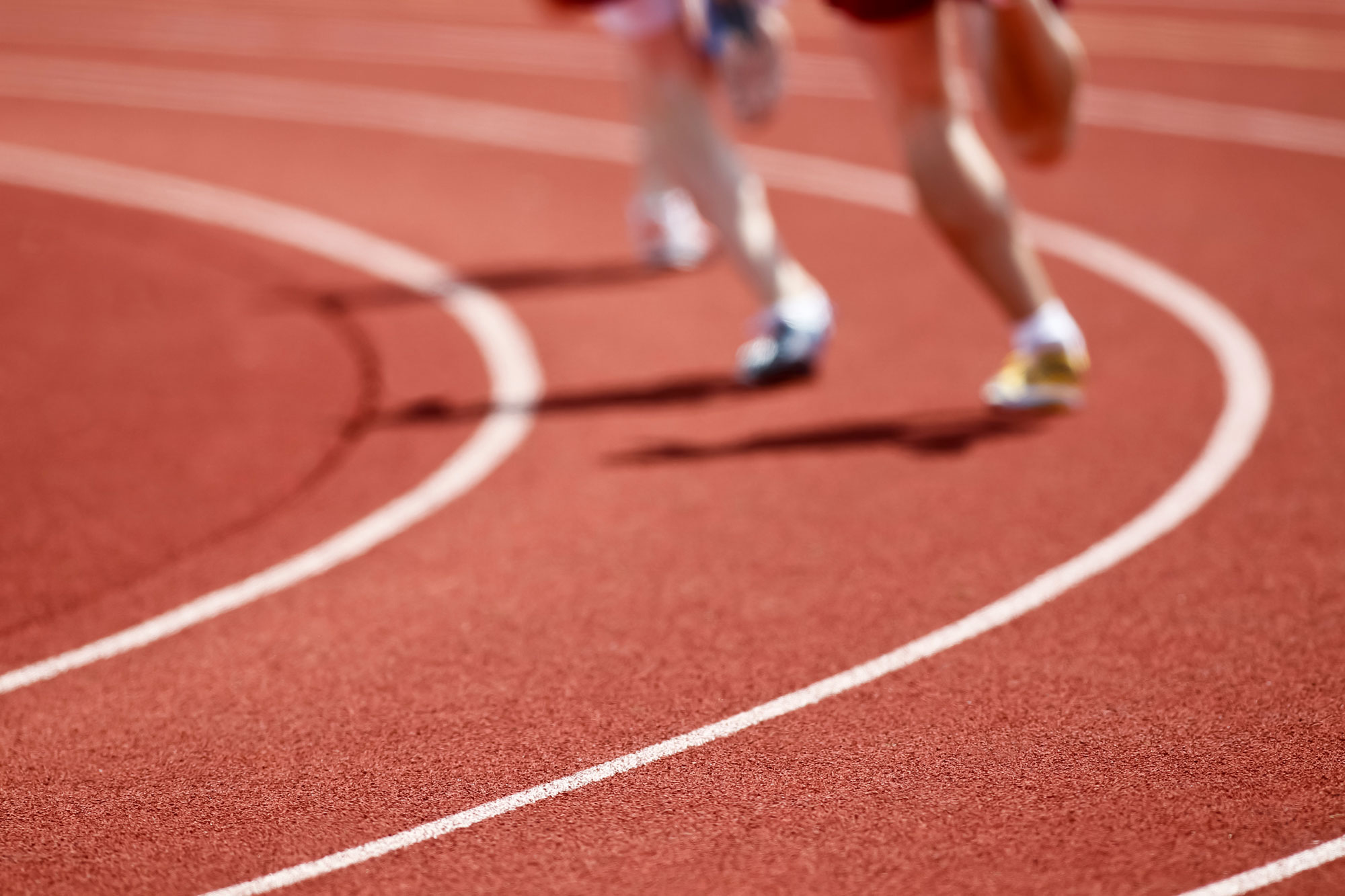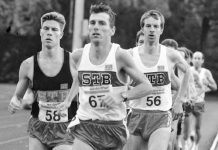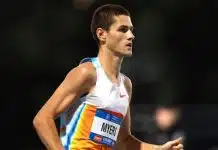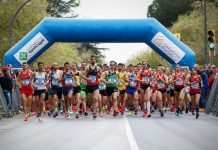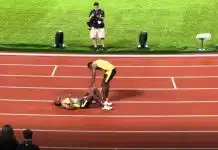In this edition of 4 Key Sessions, I want to talk about the kind of sessions I was doing to prepare for school championships and U/18 events – way back, last century.
These sessions – particularly the track sessions – are ideal for the schoolboy athlete, who is around 16/17, and who is targeting the 1500m and running around low 4 minutes and is looking to peak for the school championship season (October – December).
It should be noted that these more intense sessions should be done, initially at least, with an experienced coach in attendance and by an athlete with at least a few years of regular training and racing. Athletes should learn pace judgement and always run within their capacity. Training should be hard, but never to the absolute limit.
The quality interval sessions should be undertaken after a number of months of aerobic base building, with long, steady runs, mixed with weekly hill/fartlek runs and are a more specific session for middle-distance runners. Training should be in moderation, with gradual increases in intensity and volume.
The training sessions here were devised by my former coach and PE teacher, John Cropper. John taught in the outer western suburbs of Sydney and the Wollongong/Illawarra region, where he was also an accomplished soccer player and soccer coach. He was also a 2.40 marathoner who won a number of fun runs in the ‘80s. Here are four key training sessions for the aspiring schoolboy middle-distance runner:
FARTLEK:
Fartlek is a great session to do all year round. It can be short and sharp or take the form of a longer run with occasional surges. There is a tendency for it to be overly structured, with strictly times surges and jog/float recoveries. Something like the ‘Mona Fartlek’ is an example of this. Fartlek, from Swedish, translates as ‘speed play’. The runners of early last century who began to run fartlek, did so as a looser, much less structured session, running as they felt, surging for a few minutes, easing off, doing sprints of varying lengths – all part of a longer, continuous run. Basically, the idea was to do a hard session but make it fun.
Kids, between 14 and 17 beginning to run fartlek, could just go out – individually or as a group – and run for, say, 30-40 minutes and run slowly for 5 -10 minutes to warm up, then throw in surges. You could, say, run hard to fixed points, say a car or telegraph pole up ahead a few hundred metres ahead, then ease off, then run hard for a few minutes, then ease off, find a hill or two and sprint the hills, and continue this until about the 25-30 minute mark of the run, then take a 10 minute warm down jog. Ideally, you would do a session over undulating terrain, over a bush track or on a golf course or parkland.
A more structured session we did was something like this: 10 minute warm up run, 2 minutes hard, 1 minute easy, 2 minutes hard, 1 minute easy, 1 minute hard, 1 minute easy, 1 minute hard, 1 minute easy, 5 or 6 50m-80m sprints with 30 seconds recovery jog between them, 2 minutes hard, 1 minute. Easy, 2 minutes hard, 1 minute easy, 1 minute hard, 1 minute easy, 1 minute hard, 10 minutes warm down run.
This is a great all-round conditioning session and gets an athlete used to changing pace. The athlete should also be encouraged to maintain rhythm and a steady pace during the float recovery sections of the run. Another advantage is that, with the shorter sprints within the fartlek session, it keeps an athlete in touch with some sort of speedwork all year round. The great Olympic champion and multiple world record-breaker, Sebastian Coe was known to sharpen his speed regularly, even while in an aerobic base-building phase. He once said that he never liked to be “…more than a fortnight away from a fast 400m”.
A regular fartlek run can be run on one or two set courses throughout the year. If the runner can complete a loop of a course, with set timed surges and recoveries, in faster times over a period of a few months, it is clearly a great way of gauging fitness gains. Steve Moneghetti famously ran weekly sessions of his eponymous fartlek sessions on a 5.9km lap of Ballarat’s Lake Wendouree and knew that completing a lap in under 18 minutes meant that he was in good shape and training was going well. When he first devised the session early in his career ( a session which takes exactly 20minutes, not including warm-up and warm-down), Moneghetti would not even cover a full lap in the 20 minutes. It’s important to remember: fartlek should be hard, but it also should be fun.
HILLS:
Hills should be an important component of any middle- and long-distance runner’s regular training regime. Whether it’s regular steady runs over hills or specific hill rep sessions, coaches and athletes should seek out hilly terrain in their area – or outside their area, if they live in a flat region.
New Zealand champion Rod Dixon was an Olympic and World Cross Country Championship medallist, and a New York Marathon winner. He grew up running across the tough, hilly terrain around Nelson in the South Island, and this built the endurance and strength which carried him through a long elite-level career, in which he ran a range of world-class performances from 1500m to the marathon.
Dixon’s experience on the hills served him well in many races. Often in road and cross-country races, he would run the hills hard and maintain the surge at the crest. This would catch his rivals off guard. The tendency of many runners is to relax at the top of a tough hill, but Dixon would often accelerate at the crest and often opened a gap, then he carried his momentum down the other side of the hill and would be able to pull away from his rivals
Many of the all-time great Australian athletes – including Herb Elliott and Rob de Castella – would run hills in training to build fitness, strength and the sheer toughness required to compete at the highest level. Elliott, guided by the legendary Percy Cerutty, famously ran the sandhills of Portsea when preparing for major races, often running himself to the point of collapse. For relatively inexperienced teenagers, a more moderate approach is advisable.
A regular, weekly hill repetition session with an active (jog down the hills) recovery. Is a great workout.
It can be on a circuit, where an athlete will run a series of hills over a course, or you can pick one particular hill and run reps up and down. One of our great sessions was on a Sunday morning, when we would run the ‘Torture Course’, a series of steep hills on a loop of dirt tracks in bushland not far from our club track.
Another session was 8 reps – between warm-up and warm-down runs – up a steep 200m hill, with a jog down recovery. We ran hard, but not flat out, pushing hard beyond the crest of the hill. It is a good idea for a coach – or the kids themselves- to check pulses in the middle of the session, to see that they aren’t overdoing it Anything north of about 155bpm, and it’s a good policy to back off a little. Moderation is important until kids develop a good strength and fitness base.
Hill sessions done right will develop and anaerobic fitness, and they will naturally enhance good sprinting form – rear leg drive, high knee lift, arm drive – as well as improving strength and muscular endurance.
HIGH-REP, SHORT RECOVERY INTERVALS:
These were a key session. An example would be 14 x 400m or 20 x 200m. The 400s would be run at about 5km pace (at the time for me, around 75 sec) and, over a few months, the pace would increase to about 71-72 (about 3km pace). The 200s would be run in about 32-34 sec (roughly 4.00-4.15 1500m pace). They would be run in around 31 closer to competition time. The recoveries would be 60 seconds, dropping to as little as 50 seconds on occasion, as a way to make the session a little tougher.
Sebastian Coe ran sessions like these. A few weeks prior to his Olympic title defence in LA ’84, he ran a session of 25 x 200m in slightly faster than 1500m pace (27-28 secs), with a recovery of no more than 45 seconds. Coe had plenty in the tank at the end of the session and decided to go hard on the 25th rep and he ran a 22.5. This indicated to him that he was back to his best form, and he was right; Coe won a silver in the 800m and dominated the 1500m, smashing the Olympic record.
This is a tough type of session and best to take it slow and gradually run within yourself when you are inexperienced. These sessions adapt the athlete to high-intensity output for longer periods and also help athletes develop better pace judgement, as well as enhancing VO2 max and minimizing the need for higher mileage in training. This type of session will get an athlete fitter quickly if they have had time off and have competition coming up.
The athlete running these interval sessions can also cover a fair bit of ground in a session. Considering a set of 14 x 400m, an athlete may cover over 11km, most of it at a fair pace, when you factor in the reps and recovery jogs, as well as a 2km warm-up and a 2km warm-down. Again, it’s a tough session, so take it slow early.
QUALITY INTERVALS:
These are done primarily by middle distance runners, but they can be a useful session for distance athletes returning to the track, as a way to sharpen up and get the athlete used to running faster for sustained periods.
For the high school middle distance runner, aiming for an end of year peak, these reps are generally done over about 6 weeks, from, say mid-August, continuing through to October, then sessions would be run in mid-season, during the summer, through until Feb-March. It’s probably best to phase them in gradually, with no more than a couple of sessions a week, along with a race or time trial during the week to get the athlete ready for the big events. During this time, the athlete would drop their mileage a little and focus on quality, with maybe a slightly shorter weekly long run and a few easy or steady recovery runs during the week.
The aim is, as mentioned, for the athlete to cope with sustained faster running, and to enhance the athlete’s cruising speed (the pace at which the athlete is comfortable). Both the cardiovascular and muscular-skeletal systems will adapt to the workouts over several weeks, and results will follow.
My own sessions would be various race pace sessions, or slightly quicker than race pace. For example, I would do 6 x 300m in 44-45 (800m pace), 8 x 200m in 28-29 (quicker than 800m pace) or 6 x 400m in 61- 62 (slightly quicker than 1500m pace). They are to be run in sets of 2, with 90 seconds recovery and 4-6 minutes between the sets.
The aim is to slightly increase the pace by about a second per rep over a few weeks. Perhaps the runner could also decrease recovery periods by 10 seconds, to make the sessions a little more tough.
The most extreme example of these high-intensity sessions might, again, from Coe. Coe used some of the sessions to gauge his preparedness for races. Two of these race pace type sessions were particularly tough. Coe regularly ran 6 x 800m on the road, on a stretch of the Rivelin Valley Road in his hometown of Sheffield. He would run 6 x 800m in 2 minutes, with 90 seconds rest. Before a world record mile in 1979, he ran the session in an average of 1.53 (about 3.47-48 mile pace), and he ran the last one in 1.49! He beat the world record by half a second and ran 3.48.95. Another session was 8 x 300m in 39 with (1.44 800m pace) with only 60 seconds rest. At his peak, he was able to average 38 seconds, and this equates to about 1.41.5 800m pace. His long-standing world record, run in 1981, was 1.41.73. Remember, athletes the calibre of Coe had years of hard, scientifically developed training, so these types of sessions should not be attempted, by athletes until they have good coaching, and years of experience. You need to get good advice and tailor your training to your own talents and fitness level.
Outside these sessions, junior athletes running the middle-distance events at around the 2 min 800m, 4 minute 1500m and the 8.30-50 3km should run a long run once a week, maybe gradually build up to as much as 18km or so when in the aerobic base phase and drop down to 13-14 during track season. They should do regular steady runs of 8-11k on easy days and have one easy day a week, where they run no more than 8km. Weights are a good supplementary session, maybe once or twice a week, but it’s best not to do weights for 4 days before a competition. Stretch before and after races/training – every day. Always listen to your coach and don’t be discouraged if things take a while to happen. Most importantly, have fun.
John Cropper produced a number of State medallists over the years, and encouraged many less-talented kids to achieve beyond what they though possible. As perhaps the least-talented and most injury-prone athlete to ever qualify for junior and senior national championships, the author can certainly attest to the efficacy of these training methods.


